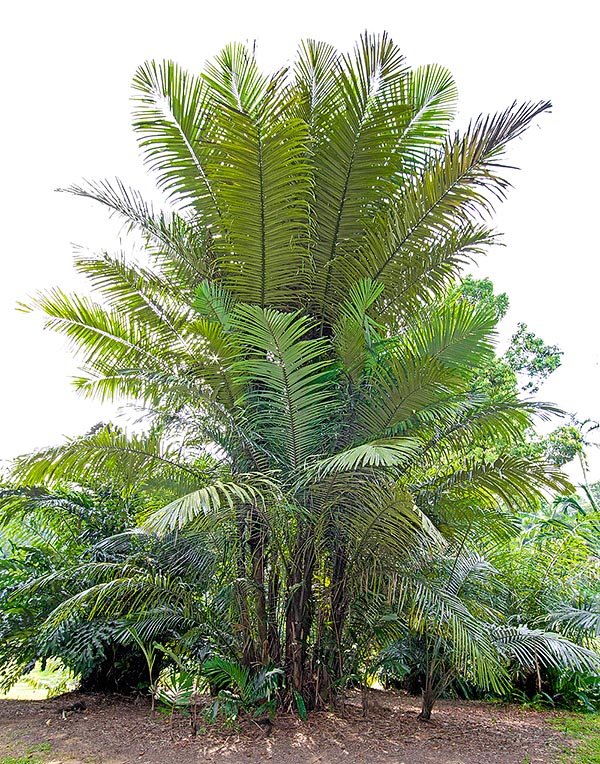Family : Arecaceae

Text © Pietro Puccio

English translation by Mario Beltramini

Beautiful but infesting, through the stolons, Arenga obtusifolia can be 8-15 m tall © Giuseppe Mazza
The species is native to Java, Peninsular Malaysia, Sumatra and Thailand where it grows in the humid forests, often representing in some areas the dominant species, up to about 700 m of altitude.
The generic name, Arenga, comes from the Malay ‘areng’ referred to Arenga pinnata; the specific name is the combination of the Latin adjective “obtusus, a, um” = blunt and of the substantive “folium, ii” = leaf, with obvious reference.
Common names: Sumatra sugar palm (English); langkap, langko, lang sap (Indonesian); ma phrao nu, phrao nu (Thai).
Arenga obtusifolia Mart. (1838) is a cespitose unarmed species, expanding through up to about 2 m long stolons, with erect 8-15 m tall stems a nd of 30 cm of diameter at the base. It shows unusual characteristics for the genus, is not monocarpic, therefore does not die after the blooming, this in the time proceeds from the bottom upwards (acropetal) and not vice versa (basipetal), and finally is monoecious, having flowers of both sexes on the same inflorescence, arranged in the characteristic triad (one female flower amid two male ones), but it has been noted that during its development all the flowers of one sex are eliminated, behaving then for the purposes of reproduction, as dioecious.
The leaves, on a 40-90 cm long robust petiole, are pinnate, slightly ascending, up to about 6 m long, with 60-100 lanceolate pinnules with irregularly toothed apex, 0,7-1,5 m long and 6-8 cm broad, irregularly arranged on both sides of the rachis on slightly different levels, of dark green colour above, silvery grey below, coriaceous. The foliar base, 0,6-1 m long , grey, surrounds the stem only minimally with margins that fall apart forming a net of blackish fibres, persistent for long time, of which some, rigid and needle-shaped, may reach the length of 1 m, only in the older part the stem is smooth, greyish and marked by rings, trace of the fallen leaves, spaced of 16-20 cm. The inflorescences originate between the leaves (interfoliar), ramified, 0,6-1 m long, the fruits are ovoid with depressed apex, greenish yellow when ripe, about 4,5 cm long and of 3 cm of diameter, containing 1-3 blackish seeds; the pulp is very irritant due to the presence of crystals of calcium oxalate, to be handled with caution, possibly wearing gloves.
It reproduces by division and by seed, utilizing in such case deep containers seen that the hypocotyl developping from the seed, and on whose extremity stays the germ from which will originate the roots and the first leaf, goes deep, with germination times, at the temperature of 26-28 °C, of more than one month.
From 2020 Arenga obtusifolia is inserted in the category LC, Least Concern of the Red List of the International Union for Conservation of Nature (IUCN).

Fruits and enlargement of female flowers. The bisexual inflorescence while growing eliminates one of the sexes becoming de facto unisexual © Giuseppe Mazza
Species of undoubtful ornamental characteristics, but that has the drawback of occupying with the time wide areas, if not duly controlled, through the long stolons it emits. Cultivable in parks and large gardens exclusively in the tropical and humid subtropical climate zones, not bearing exceptional values of temperature around the 0 °C, if not for extremely short time and with damage to the foliage. It requires full sun and draining soils maintained constantly humid.
The fruits are at times used for feeding the pigs and the leaves as cover of makeshift shelters and for making baskets. In some Java areas it has become infesting choking the existing vegetation, in particular menacing the survival of the Javan rhinoceros (Rhinoceros sondaicus Desmarest, 1822), reduced to few tens of specimens in the Ujung Kulon National Park, and obliging the local authorities to set up response plans in order to try to limit its expansion and foster the regrowth of the vegetation of which it feeds.
Synonyms: Gomutus obtusifolius Blume (1843); Saguerus langbak Blume (1843).
→ For general notions about ARECACEAE please click here.
